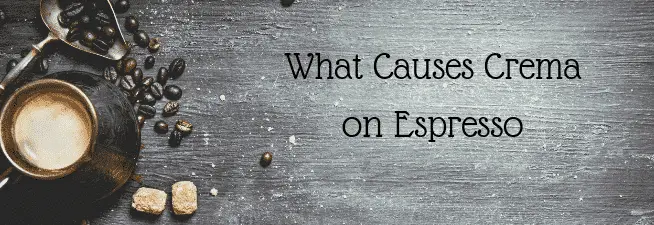
Have you ever had an espresso? Have you ever wondered how espresso gets that layer of crema on the top of it?
Well, you are in luck.
Today, we are going to learn together how exactly espresso gets its crema!
What is Crema & What Makes Crema on Espresso so Desirable?
Anytime someone mentions espresso these days, it seems like they are only concerned with one part of it. What is crema, and why is it so important?
Crema is the slightly lighter layer of liquid that forms at the top of an espresso beverage after the liquids filter and settle. This crema is often the topic of coffee maker’s conversation, because it’s perfection reveals much about the drinks quality and noteworthiness.
The appearance of crema tells a lot about the beans and technique used in the espresso production. Each of the following factor’s causes crema to form on an espresso:
- Freshness
- Plantation Location
- Roast Color
- Espresso Brewing Technique
Let’s look at each of these factors individually.
Fresh of the Beans Make Better Crema
Aside from simply tasting better, the use of fresh espresso beans during the brewing process also results in a thicker and creamier layer of crema a top the espresso beverage.
The freshness of espresso beans impacts the overall product’s crema production, because immediately after the espresso beans have been roasted they begin to emit CO2. While some CO2 is certainly recommended for the emulsification of the beans’ oils, it is also important to pull the espresso shot while some CO2 has yet to be emitted.
Waiting too long to pull shots after the espresso beans have been roasted will result in an absence of crema, where as pulling shots too early will result in “blonding”, which is often mistaken for crema.
The freshness factor of the grind is one of the main reasons why traditional espresso machines always make better espresso than pod-based machines like Nespresso.
Read more: Does Nespresso make good/real espresso?
Plantation Location Affects Crema Too
The crema on an espresso beverage can reveal the location where the beans used in the brewing process were produced. This is ultimately because different coffee plantation’s use different techniques based on their climate and weather.
A bean produced in Africa or Brazil normally produces a perfect layer of crema, as the beans are dry processed.
Where as, beans from plantations in Sumatra as an example are often wet processed, which leaves them with a very different taste and amount of oils.
Some plantations make more Robusta beans too which is frequently used in espresso.
Why Espresso Blends Contain Robusta
First it is worth addressing what Robusta is.
Robusta is a type of coffee bean. There are two major types that the world produces, Arabica and Robusta.
Robusta is typically grown in Africa or Indonesia, with Vietnam being the largest producer.
Robusta is used in making espresso blends as well as for instant coffees for largely the following reasons.
The Flavor & Crema Boost
High quality Robusta beans are used to make a delicious espresso, lending their bitter flavors and the often desired crema to the cup.
If you enjoy a bitter flavor to your coffee the Robusta type may be just your style.
Increased Caffeine Content
People often order espresso as a pick me up when they feel they need an extra boost. While dark roasted coffee contains less caffeine than light roast, Robusta may be chosen for espresso in part due to its high caffeine content, double that of the more traditional Arabica bean.
It is also this caffeine content that helps add to the bitter and dark flavor Robusta beans offer.
Lower Sugar Levels
Robusta beans are known for having a lower sugar content than their Arabica cousin. With about half the sugar content and double the bitter caffeine, it’s no surprise these beans are more robust in flavor.
Finally the Cost is Lower
Robusta beans begin to produce fruit in half the time of their Arabica cousins, two years growing time versus four. The Robusta bean also produces a larger crop than Arabica. This makes the Robusta bean significantly cheaper to produce as it begins bearing profit much faster.
Combined with its bitter flavor profile, Robusta beans have become a cheaper coffee, which can be used in some lower cost roasts as filler along with Arabica.
Tradition
Espresso was first made in Italy and is still very much an Italian traditional beverage. The crema produced by the Robusta bean is expected, not option, in an Italian espresso. With Italy as the creator of the beverage, it would be expected that the original blend of about 80/20 Arabica to Robusta will continue to be a traditional option.
Does Roast Color Change the Crema At All?
Though, all dark, medium, and light beans produce roughly the same amount of oil, dark beans can be said to produce less crema.
This lack of production is mainly the result of the tendency for dark beans to release their oils to the surface.
These oils often transfer to brewing equipment and coffee packaging materials. Therefore, it is not uncommon to see an oily residue on grinders and other equipment after brewing with a large amount of dark beans.
The Brewing Technique Makes a Huge Difference in the Formation of Crema
Fancier brewing machines often appear to produce perfect layers of crema more frequently. Though, some of these results are an illusion created by the machine.
A portafilter is often included on most expensive machines that are used in the mass production of espresso beverages.
These portafilters aerate the coffee during the pulling process which gives the appearance of crema.
These layers of “crema” lack the oils and fats from the emulsification process that gives the layer its flavor.
If you use a standard (or less fancy) espresso machine it may look like you are getting less crema because of the aeration or lack thereof but in fact most machines will produce crema just fine so long as you are using fresh beans from a region that is known for producing espresso style coffee beans.
But what if you don’t seem to be getting as much crema as you would expect?
Reasons Why An Espresso Machine Isn’t Making Crema
While there are no parts on your espresso machine that are particularly responsible for creating crema, the golden layer of foam all espresso drinkers aspire to create, there are adaptations one can perform in order to more consistently achieve their desired results.
Since repairing the espresso machine’s parts will not warrant any changes to its crema production, most solutions to any crema production problem fall upon the ingredients used in the brewing process.
These are the top reasons why your espresso machine isn’t making crema:
- Water Pressure
- Coffee Bean Selection
- Coarsity of Coffee Grind
Again, let’s look at each of these factors one-by-one.
Your Water Pressure Could be Causing a Lack of Crema
Crema is created as a byproduct of the espresso brewing process. When the espresso machine forces a jet of highly pressurized water through the coffee grinds, the water and oils in the coffee begins to emulsify. This emulsification releases CO2 from the coffee grounds, which creates that lovely crema.
The Coffee Bean Your Are Using Could Be The Problem
Across the board, different varieties of coffee beans contain different levels of oil. This level of oil matters, for as we learned before the coffee’s oil eventually translates into crema production.
As a general rule, coffee beans with a darker roast typically contain a higher level of natural oils.
A subset of the same problem, fresh coffee beans have been said to produce better crema, for their freshness certifies that their oil and nutrient levels are closer to the company’s production value.
Your Espresso Grind Might be to Coarse
The coarsity of coffee grinds used in the espresso brewing process really matters.
When coffee grinds that are too fine are used to brew espresso, the machine often has a hard time forcing water through the coffee, for finely ground coffee can form an almost solid block. Hardly penetrated, this block of coffee normally produces espresso with only a dribble of crema; if any is produced at all.
To amend this problem, coffee enthusiasts usually opt to use a coarser grind of their favorite bean. When and if the problem persists, these same enthusiasts keep increasing the grinds coarseness until the desired result is achieved.
If you buy pre ground coffee beans, this might be the time to give another brand of coffee a try.
It may take a few tries to get a coffee grind that satisfies both your love of crema and your taste profile, but once you do that perfect shot of espresso is waiting for you each morning.
